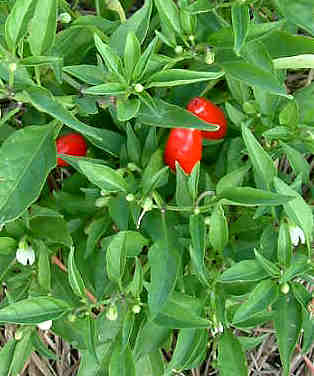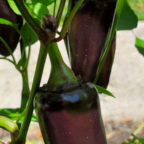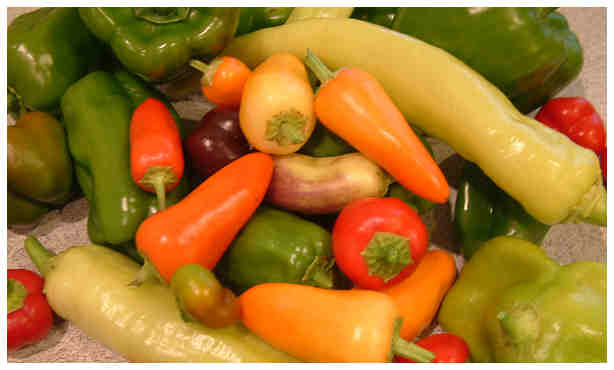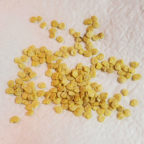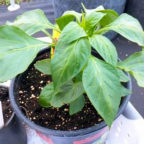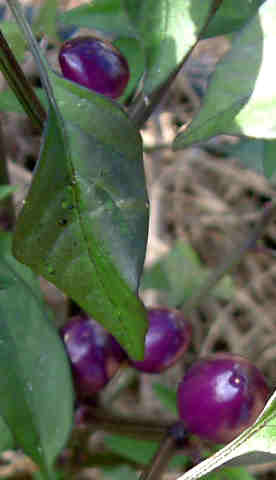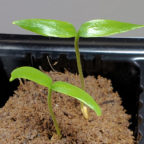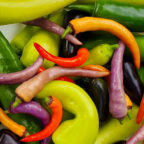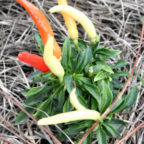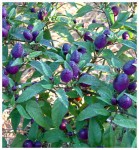Growing Thai Hot Peppers
Growing Thai Hot Peppers means you’re growing a delight.  The low-growing plant blossoms profusely and produces a bounty of bright red peppers, pointing upwards.
A Little About the Peppers
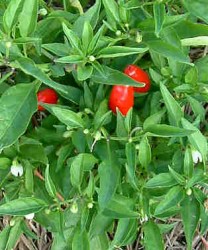 Thai Hot is equally at home in a container or in the ground. A three-gallon container will suit this pretty little pepper just fine. You might even be able to get away with a 1-gallon container, if you keep it well-watered and fertilized.
Thai Hot is equally at home in a container or in the ground. A three-gallon container will suit this pretty little pepper just fine. You might even be able to get away with a 1-gallon container, if you keep it well-watered and fertilized.
I have the plant in the photo (and by the way, you can click on the photo to see a larger picture) growing in the ground, and it’s about 8-inches tall. It’s also spread about 7 inches in diameter.
Now in the photo you only see 3 red peppers, but see all those blossoms and blossom buds? In a couple of weeks, the plant will be covered with peppers.
Can You Eat the Peppers?
Sure you can, but be warned –they aren’t called “Thai Hot” for nothing! One chopped pepper (with seeds) can easily season a large bowl of chili.
Speaking of the peppers, they are only about 3/4″ tall. They aren’t large, but they are potent.
But the charm of these peppers is ornamental. They make a great garden border, looking like bright red flowers. And of course, you could each day pick a few of the peppers in the border and you’d never see a difference.
Growing Thai Hot Peppers
My pepper plant survived some very chilly weather early this season, with temperatures down in the 30’s. It was a little sad-looking until the cold weather passed, but then came back admirably.
As with all chile peppers, they like warm weather and plenty of sunshine. I mentioned that you can grow these in containers easily, and Thai Hot could certainly be grown indoors under lights.
An an FYI, there is a larger variety, called Giant Thai Hot. I haven’t tried it yet, but the peppers get to about 2″ long, instead of the normal 1/2 to 3/4 inches. There’s also a version that has orange peppers instead of red.
Pretty Purple Pepper in the Garden
Pretty Purple Pepper is not only a variety name, but an accurate description of the plant and its fruit! Let’s talk a little about growing this wonderful pepper variety in the garden.
How Does it Look?
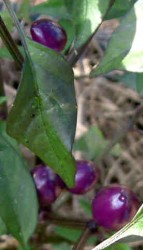 It’s really hard to capture with a photo how lovely both the plant and the peppers are! The stems are a deep purple-maroon color, and the leaves have a violet sheen to them (which I can’t seem to capture). And the peppers — they are a gorgeous, glowing purple.
It’s really hard to capture with a photo how lovely both the plant and the peppers are! The stems are a deep purple-maroon color, and the leaves have a violet sheen to them (which I can’t seem to capture). And the peppers — they are a gorgeous, glowing purple.
This pepper has been quite hardy in my garden. It’s faced a near-freeze with grace, and is thriving in a 3-gallon container. I drop by it at least once a day because it’s a feast for my eyes.
(You can click on the photo for a larger image.)
Germinating the Seeds
I find that germinating seeds for this pepper to be easy. Even in a cooler temperature than normal, the plant came up within 10 days. I imagine that if I used a heat mat, that would shorten to 5-7 days.
I germinated this particular plant at cooler-than-normal temperatures as an experiment. Pretty Purple Pepper sprouted well, but the other seeds had a hard time, and most didn’t germinate at all.
(Here’s more information about germinating hot pepper seeds, if you need a few tips.)
Container Growing
I mentioned that I am currently growing this plant in a 3-gallon container, and it is thriving. While it would do better in the ground, it’s quite suitable for a lovely container plant on a patio. Not only is the plant pleasing to look at but it also has purple-and-white flowers. When the plant has flowers and peppers at the same time, it’s a sight to behold!
Other Hints for Pretty Purple Pepper
As I mentioned, this plant has had some tough conditions. Not only has it faced temperatures in the 30’s, but it’s also faced extended periods of high winds. The weather has been dry, and sometimes the soil isn’t as damp as I’m sure the plant would like. Through all this, Pretty Purple Pepper has sailed on without a problem.
What About Eating Them?
You can certainly eat these peppers, but they are quite hot — my guess is around 40,000 Scoville Units. I don’t eat a lot of them, because they are so lovely on the plant. But I reccomend them  in stir-fries and also for a vinegar pepper. And although I haven’t tried them as such, I imagine they would be good pickled.
I like Pretty Purple Pepper, and it has an ongoing spot in my garden. I hope you like it too!
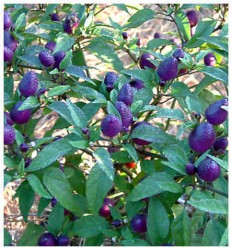
Update
Here’s another photo just a couple weeks later of the same plant!
Growing Banana Peppers
Growing banana peppers is really easy, as they are one of the most forgiving varieties. Still, they do need some care. Let’s take a look at growing banana peppers in the garden.
Type of Banana Peppers
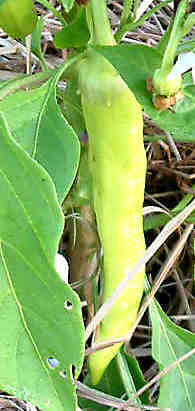 These versatile veggies go by several names, but they can be divided into two main types:Â sweet banana peppers and hot banana peppers.
These versatile veggies go by several names, but they can be divided into two main types:Â sweet banana peppers and hot banana peppers.
The most common banana pepper is called Hungarian, and it’s also available both ways. So that’s something to keep in mind when you are perusing the seeds!
The hot variety of the banana pepper reaches around 3,500 to 4,000 Scoville Units — about on par with jalapenos.
Growing Banana Peppers in Containers
Sure, you can grow these peppers in containers. For a bountiful harvest, I suggest 5-gallon containers. However, with a good potting soil, plenty of fertilizer, water and sunshine, they can also be grown successfully in 3-gallon pots.
Here’s more detailed information about container pepper growing.
Peppers in the Garden
Peppers, including the bananas, have similar requirements to their relative the tomato. That includes a fertilizer that has more phosphorus (the middle number of the fertilizer content) than nitrogen. While a lot of nitrogen will grow you large, lush plants, you won’t get many peppers off it.
Peppers like rich, well-drained soil. I’ve found that they also appreciate “fluffy” soil, which doesn’t compact easily, but which holds enough water to keep the plant happy. I do this by incorporating compost, sphagnum moss and perlite in the planting hole and surrounding soil.
Peppers like warm weather, especially the hot varieties. They don’t appreciate a windy location, so if you do get really breezy on a regular basis, see about constructing a wind break of sorts.
What About Eating?
You can eat the banana peppers when they are immature (green), ripe (red) or anywhere in between!
Here’s a hint: a sweet pepper will grow sweeter the riper it gets. Similarly, a hot banana pepper will turn up the heat, the riper it is.
Enjoy growing (and eating) your banana peppers!
